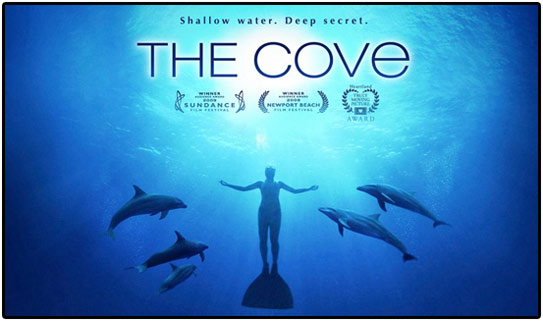Why “The Cove” Won the Oscar For Best Documentary Feature
My girlfriend Erin and I recently attended an annual Academy Awards party with friends who dress up like Hollywood stars. My sweetie said my nylons looked like high school tights, and later a new acquaintance told me that black was not a good color for me. But later I enjoyed a moment of pride when my prediction that The Cove would win Best Documentary Feature came true.
While much has been written on Doculink about the controversy surrounding the winner of the Short Documentary competition, what impressed me about the Oscar for Best Documentary Feature was the director’s acceptance in speech.
Fisher Stevens said, “It was an honor to … try to make an entertaining film that also tries to enlighten everybody.” You can see the acceptance speech here:
http://www.huffingtonpost.com/2010/03/07/text-dolphin-to-44144-wha_n_489456.html?ref=fb
The Cove is my favorite documentary from 2009 precisely because it tackles a horrific environmental justice issue — dolphin slaughter — and makes it as entertaining as a superhero comic book, thus ensuring big audiences (who badly want to be entertained), and big awards.
How did the filmmakers do this? They used narrative techniques.
First, the film begins in the midst of conflict, as protagonist Ric O’Barry, drives through Taiji, a Japanese village, with the bad guys trailing his car.
The inciting incident for The Cove is amazing. O’Barry, a former dolphin trainer for the TV show Flipper, tells how one day Flipper swam into his arms, looked him in the eye, and “commited suicide.” Apparently dolphins can consciously stop their breathing and willfully die. The marine mammal was being driven crazy by the close enclosures of the training tank. This event propelled O’Barry to work for the release of dolphins worldwide.
There’s plenty of conflict, backstories and reversals in Act Two of this entertaining documentary, as O’Barry and his team strategize how to infiltrate the harbor and document on camera the horrific bloodbath.
The film’s climax consists of three key scenes: the undercover nighttime planting of security cameras to document the slaughter, the actual slaughter caught on tape (a kind of “obligatory” climax) and the screening of the slaughter footage at an international whaling convention. Congratulations to Louis Phihoyos for entertaining his audience and getting his environmental justice message heard by using narrative strategies native to screenwriters!
If you’d like to learn more about the kinds of narrative devices that can create an award-winning, entertaining documentary that people will actually watch, please investigate my popular online course, available here:
